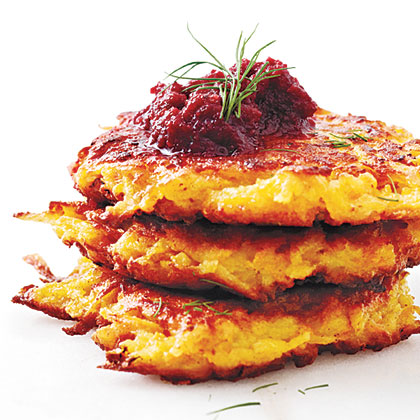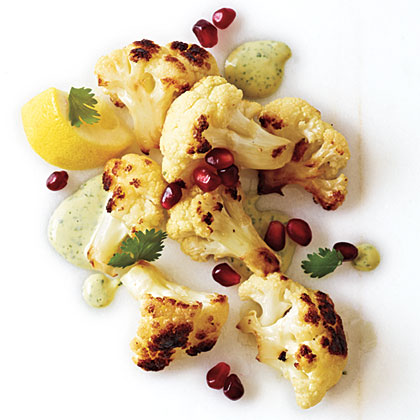 This year Hanukkah is going to be a little different. First of all I'm going to be a judge at a big deal latke competition with other Brooklyn foodies at BAM on December 10th. I was honored to be asked by Liz Neumark, creator and impresario of Great Performances and owner of Katchkie Farms and Sylvia Center. Everything she touches is magical and meaningful. I'm thrilled to be joining Leonard Lopate, Gabriella Gershenson from Saveur, and Lee Schrager from the New York Wine and Food Festival. We will be sampling 17 different kinds of latkes and you can join me! Just reserve your spot by clicking here. Even though I'm not a maven, Hanukkah has always been special. My family was once featured in a cover story in Gourmet Magazine about my three-ingredient Hanukkah celebration at home. This month, I have written a story about Hanukkah in my Cooking Light column called Radically Simple. You can check out the recipes below. And on December 14th, along with the true food maven Arthur Schwartz, I will be a judge at an applesauce! tasting at Park Slope's very cool synagogue Congregation Beth Elohim. As most of you know, Hanukkah is a holiday filled with illuminating rituals: Eight nights of candle-lighting and gifts, and foods fried in olive oil! The former refers to the miracle that happened during the rededication of The Temple in Jerusalem in 165 BC, when a tiny bit of oil, enough to last only one night, lasted eight. The latter are edible expressions of the miracle: Crispy potato pancakes, known as latkes, and jelly doughnuts (known as sufganiyot), traditionally top the list. But this year, a few new dishes will grace our table at home: nuggets of cauliflower fried in olive oil and served with tahini & pomegranate seeds, and radically simple latkes made with three root vegetables.
Every household prepares latkes differently but grating a little of one’s knuckle into the mixture is often a reality! Once upon a time, latkes were made from potatoes only but this year, ours include sweet potatoes and parsnips, and a bit of exotic perfume provided by ground cumin. Another twist? Instead of ubiquitous applesauce as an accompaniment, I serve these crispy latkes with a dazzling beet puree meant for dipping or drizzling.
This year Hanukkah is going to be a little different. First of all I'm going to be a judge at a big deal latke competition with other Brooklyn foodies at BAM on December 10th. I was honored to be asked by Liz Neumark, creator and impresario of Great Performances and owner of Katchkie Farms and Sylvia Center. Everything she touches is magical and meaningful. I'm thrilled to be joining Leonard Lopate, Gabriella Gershenson from Saveur, and Lee Schrager from the New York Wine and Food Festival. We will be sampling 17 different kinds of latkes and you can join me! Just reserve your spot by clicking here. Even though I'm not a maven, Hanukkah has always been special. My family was once featured in a cover story in Gourmet Magazine about my three-ingredient Hanukkah celebration at home. This month, I have written a story about Hanukkah in my Cooking Light column called Radically Simple. You can check out the recipes below. And on December 14th, along with the true food maven Arthur Schwartz, I will be a judge at an applesauce! tasting at Park Slope's very cool synagogue Congregation Beth Elohim. As most of you know, Hanukkah is a holiday filled with illuminating rituals: Eight nights of candle-lighting and gifts, and foods fried in olive oil! The former refers to the miracle that happened during the rededication of The Temple in Jerusalem in 165 BC, when a tiny bit of oil, enough to last only one night, lasted eight. The latter are edible expressions of the miracle: Crispy potato pancakes, known as latkes, and jelly doughnuts (known as sufganiyot), traditionally top the list. But this year, a few new dishes will grace our table at home: nuggets of cauliflower fried in olive oil and served with tahini & pomegranate seeds, and radically simple latkes made with three root vegetables.
Every household prepares latkes differently but grating a little of one’s knuckle into the mixture is often a reality! Once upon a time, latkes were made from potatoes only but this year, ours include sweet potatoes and parsnips, and a bit of exotic perfume provided by ground cumin. Another twist? Instead of ubiquitous applesauce as an accompaniment, I serve these crispy latkes with a dazzling beet puree meant for dipping or drizzling.
For dessert, there is no simpler offering than fleshy dried Calimyrna figs and Medjool dates served…frozen! They taste like candy and are a delicious with morsels of bittersweet chocolate or gold-foiled Hanukkah gelt, to be eaten one-by-one. Come to the latke tasting! Try my latke recipes in Cooking Light! And enjoy.
Crispy Root Vegetable Latkes with Beet Puree Get the latkes going first, and while they cook, puree the sauce.
2 cups grated peeled sweet potato 2 cups grated peeled baking potato 1 cup grated peeling parsnip 3 ounces all-purpose flour (about 2/3 cup) 1/2 teaspoon ground cumin 1/2 teaspoon kosher salt, divided 2 large eggs 1 cup grated onion 2 tablespoons olive oil, divided 1 tablespoon chopped dill (optional) 1 cup chopped, peeled apple 3 tablespoons water 1 tablespoon extra-virgin olive oil 1/4 teaspoon kosher salt 1/8 teaspoon ground red pepper 1 (8-ounce) package precooked red beets, drained
1. Preheat oven to 325°.
2. Place first 3 ingredients on paper towels; squeeze until barely moist. Weigh or lightly spoon flour into dry measuring cups; level with a knife. Combine flour, cumin, 1/4 teaspoon salt, eggs, and onion in a bowl; beat with a mixer at medium speed until blended. Add potato mixture; beat with a mixer at low speed until combined.
3. Heat a large nonstick skillet over medium heat. Add 2 teaspoons oil; swirl. Heap 3 tablespoons potato mixture into pan to form a patty; flatten slightly. Repeat procedure 5 times to form 6 patties. Reduce heat to medium-low; cook 6 minutes on each side or until golden brown. Place latkes on a baking sheet; keep warm in oven. Repeat procedure twice with remaining oil and potato mixture to yield 18 latkes total. Sprinkle latkes with 1/4 teaspoon salt. Garnish with dill, if desired.
4. Combine apple and remaining ingredients in a food processor; process until smooth. Serve with latkes. Serves 6
Fried Cauliflower with Tahini and Pomegranate Seeds Cilantro gives this a bright, zippy taste and lovely color; the leaves are especially festive when strewn with pomegranate arils over the cauliflower. Serve with hot sauce and cut lemons, if you wish.
1/3 cup cilantro leaves, packed 1/3 cup tahini (roasted sesame seed paste) 3 tablespoons fresh lemon juice 2 garlic cloves 6 tablespoons water 1/2 teaspoon salt, divided 2 tablespoons extra-virgin olive oil 6 cups cauliflower florets (about 1 large head) 1/4 teaspoon freshly ground black pepper 1/3 cup pomegranate arils
1. Preheat oven to 375°.
2. Combine first 4 ingredients in a food processor; process until smooth. Add 6 tablespoons water, 1 tablespoon at a time, until mixture is the consistency of a creamy salad dressing. Add 1/4 teaspoon salt; pulse to combine.
3. Heat a large nonstick skillet over medium heat. Add oil to pan; swirl to coat. Add cauliflower; cook 10 minutes or until lightly browned, stirring occasionally. Place cauliflower on a jelly-roll pan lined with foil. Roast cauliflower at 375° for 18 minutes or until tender, turning once. Sprinkle with remaining 1/4 teaspoon salt and pepper. Add pomegranate arils; toss to combine. Serve with tahini mixture. Serves 6


